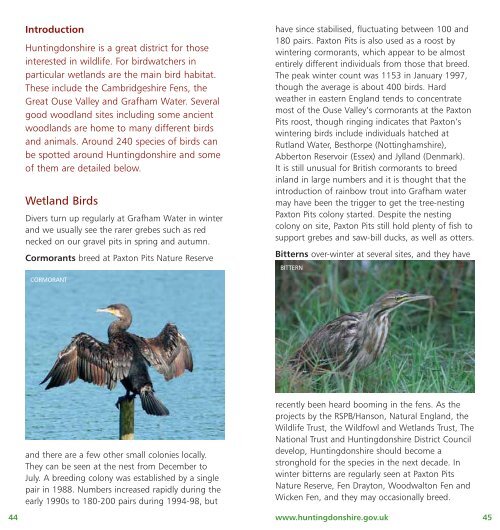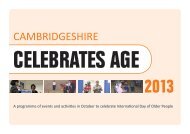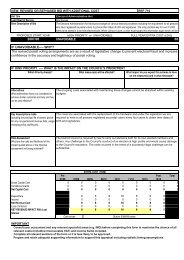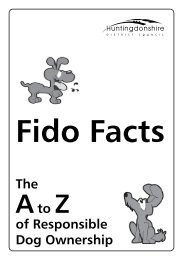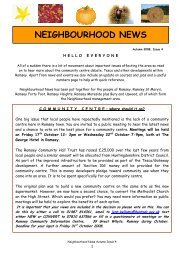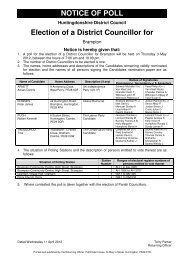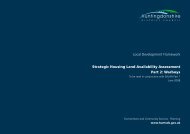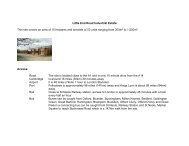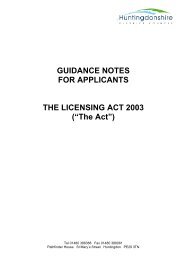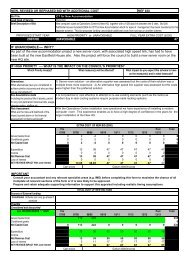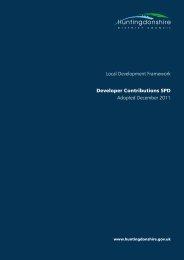Countryside Guide - Huntingdonshire District Council
Countryside Guide - Huntingdonshire District Council
Countryside Guide - Huntingdonshire District Council
You also want an ePaper? Increase the reach of your titles
YUMPU automatically turns print PDFs into web optimized ePapers that Google loves.
Introduction<br />
<strong>Huntingdonshire</strong> is a great district for those<br />
interested in wildlife. For birdwatchers in<br />
particular wetlands are the main bird habitat.<br />
These include the Cambridgeshire Fens, the<br />
Great Ouse Valley and Grafham Water. Several<br />
good woodland sites including some ancient<br />
woodlands are home to many different birds<br />
and animals. Around 240 species of birds can<br />
be spotted around <strong>Huntingdonshire</strong> and some<br />
of them are detailed below.<br />
Wetland Birds<br />
Divers turn up regularly at Grafham Water in winter<br />
and we usually see the rarer grebes such as red<br />
necked on our gravel pits in spring and autumn.<br />
Cormorants breed at Paxton Pits Nature Reserve<br />
CORMORANT<br />
have since stabilised, fluctuating between 100 and<br />
180 pairs. Paxton Pits is also used as a roost by<br />
wintering cormorants, which appear to be almost<br />
entirely different individuals from those that breed.<br />
The peak winter count was 1153 in January 1997,<br />
though the average is about 400 birds. Hard<br />
weather in eastern England tends to concentrate<br />
most of the Ouse Valley’s cormorants at the Paxton<br />
Pits roost, though ringing indicates that Paxton’s<br />
wintering birds include individuals hatched at<br />
Rutland Water, Besthorpe (Nottinghamshire),<br />
Abberton Reservoir (Essex) and Jylland (Denmark).<br />
It is still unusual for British cormorants to breed<br />
inland in large numbers and it is thought that the<br />
introduction of rainbow trout into Grafham water<br />
may have been the trigger to get the tree-nesting<br />
Paxton Pits colony started. Despite the nesting<br />
colony on site, Paxton Pits still hold plenty of fish to<br />
support grebes and saw-bill ducks, as well as otters.<br />
Bitterns over-winter at several sites, and they have<br />
BITTERN<br />
and there are a few other small colonies locally.<br />
They can be seen at the nest from December to<br />
July. A breeding colony was established by a single<br />
pair in 1988. Numbers increased rapidly during the<br />
early 1990s to 180-200 pairs during 1994-98, but<br />
recently been heard booming in the fens. As the<br />
projects by the RSPB/Hanson, Natural England, the<br />
Wildlife Trust, the Wildfowl and Wetlands Trust, The<br />
National Trust and <strong>Huntingdonshire</strong> <strong>District</strong> <strong>Council</strong><br />
develop, <strong>Huntingdonshire</strong> should become a<br />
stronghold for the species in the next decade. In<br />
winter bitterns are regularly seen at Paxton Pits<br />
Nature Reserve, Fen Drayton, Woodwalton Fen and<br />
Wicken Fen, and they may occasionally breed.<br />
44 www.huntingdonshire.gov.uk<br />
45


